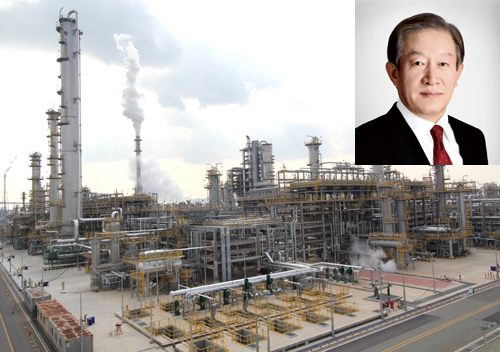Refiner now has the largest heavy oil cracking capacity with its 4th heavy oil cracking tower online

A view of the 4th heavy oil cracking tower at GS Caltex, boosting the oil refinery’s heavy oil cracking capacity
to 268,000 bpd. (Inset) V.Chmn. Huh Jin-soo of GS Caltex Corp. (Photo: GS Caltex)
Vice Chairman Huh Jin-soo of GS Caltex, in his New Year’s speech, said the management crisis has become a daily routine with the concern of environmental uncertainty and the competition for survival growing tougher, thus the company should fight for survival with selection and concentration in its operations.
GS Caltex turned over gas, electricity, material exploration, and green growth to mother company GS Energy in June last year to focus on oil refining, petrochemicals, and lubrication oil, among other sectors, to concentrate on its key businesses.
The oil refiner’s new strategy also was made apparent when its fourth heavy oil cracking center was dedicated in March at a cost of 1.3 trillion won, completing the construction in only two years.
The dedication of the new heavy oil cracking facility with the capacity to crack 5,300 barrels of heavy oil daily has put an end to the heated competition among oil refiners with GS Caltex having the largest heavy oil cracking capacity at 268,000 barrels daily, followed by SK Energy with 212,000 barrels, S-Oil at 148,000 barrels, and Hyundai Oilbank at 134,000 barrels.
Called “oil fields on land,” the heavy oil cracking facilities squeeze light oil products from residual heavy oil such as gasoline, diesel, and kerosene, all expensive oil products. The oil refining industry in Korea built its first residual fuel-cracking center in Korea in 1995 with a cracking capacity of 94,000 barrels of heavy oil daily.
The oil refiner built its second heavy oil cracking tower capable of handling 61,000 barrels of heavy oil daily in 2007 at a cost of 1.5 trillion won and the third one in 2010 at a cost of 2.2 trillion won.
Through construction of those heavy oil cracking centers, the GS Caltex Yeosu Complex has become a perfect complex turning out expensive light oils like gasoline and diesel, enhancing its operational competitiveness.
The oil refinery has also been at work developing bio butane, a next generation fuel oil, along with bio diesel, and bio ethanol, which are considered the three largest future energy sources. Bio butane can be used to power gasoline driven cars without changing their engines.
GS Caltex secured core technologies for producing bio butane through joint research with the Korea Chemical Research Institute, Kwangwoon University, and the Korea Science Technology Institute. The oil refinery has more than 40 intelligent property rights in connection with the production and storage of bio butane.
The oil refinery has also been working on a new business involving the bi-products from the production of petrochemical products. The most noticeable one is the carbon textile, which is ¼ the weight of steel but 10 times stronger.
The oil refiner has been test-producing the material with the pitch left over from the production of petrochemicals and has set a target to begin commercial production of the material by 2015. The company concluded its R&D activities with other institutions including KIST, Inha University, and Chonnam Universities.
Vice Chairman Huh has been stressing expansive communication as a major means of improving GS Caltex’s corporate culture by making cooperation strong and mutual success inevitable. “Listening to the opinions of others will lead to a joint possession of information and help push forward create initiatives,” the vice chairman said.
